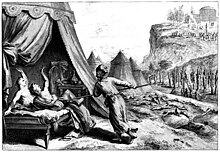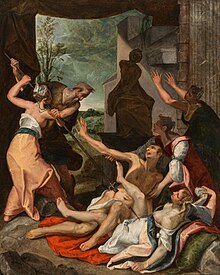Zimri (prince)


Zimri (
The incident was then taken by the Israelites as a pretext for the War against the Midianites in Numbers 31.[2]
Interpretations
Judaism
According to a
Islam
In
Christianity
According to the Revelations of Saint Bridget, after his death, Zimri's soul was condemned to hell (Book 7, Chapter 19).[6]
Later influence
In the
Thus he showed his zeal for the law, just as Phinehas did with Zimri, son of Salu. Then Mattathias cried out in the city, "Let everyone who is zealous for the law and who stands by the covenant follow me!"[7]
The Phineas Priests, a modern-day U.S. terrorist movement, believe the story of Phinehas and Zimri provides a divine mandate for committing atrocities against mixed-race couples; despite (argues Rees 2013[page needed]) the previous divine rebuke of Miriam in Numbers 12, for criticising Moses for marrying a “Cushite woman,” which confounds this reading.[8]
Notes
- ^ In this interpretation of Numbers 25, Phinehas killed the Israelite man Zimri and the Midianite princess Kozbi (verse 7–8) as they were having sex in an ordinary tent in the Israelite military camp (verse 6) at Shittim near Mount Peor (verses 1–3). Outside the tents, people lay dead; apparently these are Israelites struck by the plague (verses 8–9). On the edge of the camp, soldiers stand on guard. Just outside the camp, a number of people are impaled (verse 4–5): the chiefs of the Israelite men, who engaged in sexual immorality with Moabite women and worshipped their gods (verse 1–3); this last act appears to be shown in the far background, with people on a mountain gathering around a pole, perhaps a Moabite godly idol. Engraving from Historie des Ouden en Nieuwen Testaments : verrykt met meer dan vierhonderd printverbeeldingen in koper gesneeden) ("History of the Old and New Testaments: enriched with more than four hundred printed illustrations cut in copper") (1700), published by David Martin in Amsterdam.
References
- ^ "The Eleventh Plague footnote 12 "...'I am the Lord' implies: I am He who inflicted punishment upon Samson, Amnon, and Zimri, and who will inflict punishment upon any one who will act in accordance with their practices..."". 24 June 2009.
- ISBN 9781906055721. Retrieved 14 March 2021.
- ISBN 978-965-221-034-0..
- ^ Peretz Rodman, "Shelumiel — The First Schlemiel?", The Forward, 26 May 2006.
- ^ Rubin, Uri. "Tradition in Transformation: the Ark of the Covenant and the Golden Calf in Biblical and Islamic Historiography," Oriens (Volume 36, 2001): 202.
- ISBN 978-3-8496-2254-1.
- New American Bible, Revised Edition
- ^ Anthony Rees, (Re)Reading Again: A Mosaic Reading of Numbers 25, (2013 dissertation), pp. 126–130, citing T.K. Beal, "The White Supremacist Bible and the Phineas Priesthood." In: Jonneke Bekkenkamp and Yvonne Sherwood, (eds.), Sanctified Aggression: Legacies of Biblical and Post Biblical Vocabularies of Violence (2003), pp. 120–131.
